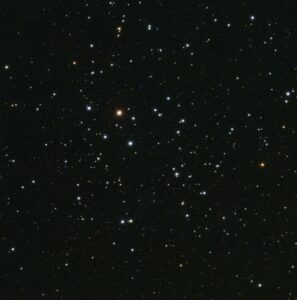NGC 2335 is an Open Cluster in the Monoceros constellation. Discovered on Jan 10, 1785, by William Herschel, it is situated close to the celestial equator, and, as such, is at least partly visible from both hemispheres at certain times of the year. NGC 2335 is also the gateway to the Seagull Nebula and is a 7th-magnitude open cluster (type III3m) in its constellation. Although not much is known about this cluster, however according to a paper published by J.J. Claria,1972 its age is estimated to be somewhere between 138 million to 164 million years making it an intermediately aged open cluster.
To study NGC 2335 and investigate the relationships between the colors, brightness, age, and chemical composition of the cluster as a whole, I selected the telescopes PROMPT-MO-1, Prompt5, and Prompt6 to capture 15 images that include 5 exposures for each of these filters-: B (for 60 sec), V (for 35 sec) and R (20 sec) such that each batch with the three filters was taken at a duration of 1 hour from each other. In all, since I was the second person observing my cluster, I set the total exposure duration as 576 (575+1) seconds. My final 15 images were captured by the Prompt6 telescope via the Skynet Robotic Telescope Network online.
After receiving these final images, I moved them to the Afterglow Workbench provided by Skynet and processed them using Afterglow’s Cosmetic Correction tool to remove artefacts caused by imperfections in the CCD. Once this was done I then used the WCS Calibration tool to extract the coordinate values for all cluster objects visible in my current viewer. These images were further aligned using the Aligner tool and images for each respective filter, were stacked using Stacker tool. This resulted in stacked B, V, and R fits for the cluster. Finally these stacked images were photometered using the Batch Photometry button to produce an apparent color image for NGC 2335 as observed from Earth.

Fig 1-: A pretty photo for the Apparent color of NGC 2335 cluster after batch photometry !
Once the batch photometry was done and the relevant files were downloaded, I moved to the Cluster Astromancer website to analyze NGC 2335 further. For this, I first, removed the field stars under Field Star Removal by tightening the ellipse formed by the cluster’s 2D proper motion scatter plot. This was done by concentrating the widely spaced graphical data for Proper Motion RA, Dec and the Distance Range. After removing as many field stars I could from the ellipse, I fetched archival data points from the catalogs-: Gaia and 2MASS for this cluster and repeated the field star removal process again.
All of the previous work helped me advance to the most important step that would help estimate common physical properties of all stars in NGC 2335—i.e. their distance, age, chemical composition, and the amount of light from them that’s been obscured by dust. This step was fitting an isochrone model to NGC 2335’s HR Diagrams.
The first graph I plotted was the (BP-RP vs RP) HR Diagram. Initially for the default values of all the parameters, the isochrone curve did not fit the data, however by refining them I was able to achieve a much better fit.

Fig 2-: (BP-RP vs RP) HR Diagram with its isochrone curve fit for NGC 2335
To make sure, these estimates for distance (in kpc), log(Age) (in years), metallicity (solar units), and E(B-V) were tight and accurate I plotted another graph to fit the isochrone model, this time being a (J-H vs H) HR Diagram

Fig 3-: (J-H vs H) HR Diagram with its isochrone curve for NGC 2335
These were my final estimates that I was able to deduce based on all of my previous observations and analysis for NGC 2335
o Classification-: OPEN
o Number of stars-: 2397
o Mass-: 461453.97709230817 (solar)
o Physical Radius-: 12.79 (ly)
o RA-: 106.67°
o Dec-: –10.02°
o Galactic Longitude(l)-: 43.5869358516611°
o Galactic Latitude(b)-: –1.2071000860062°
o Angular Radius-: 0.15600549709124656°
o Proper Motion RA-: –0.76 (mas/yr)
o Proper Motion Dec-: 0.15 (mas/yr)
o Velocity Dispersion-: 1.0422725737299756 (mas/yr)
o Distance-: 1.44 (kpc)
o Log Age-: 8.85 log(yrs)
o Age-: 707.95 (Myrs)
o Metallicity-: –0.15 (solar)
o E(B–V)-: 0.32 (mag)

